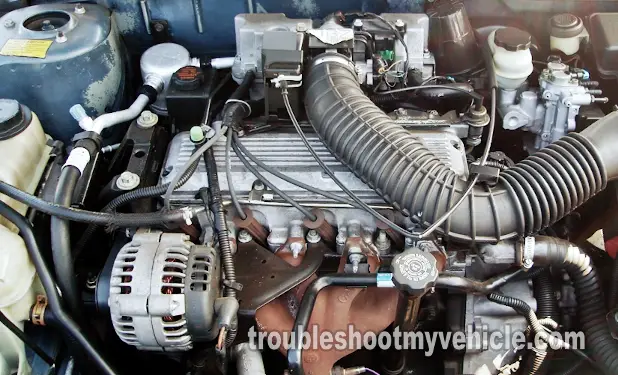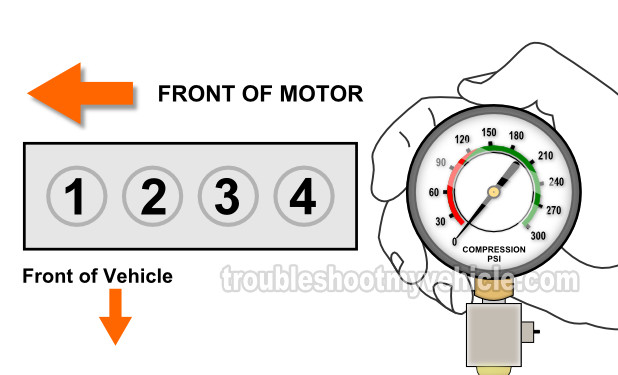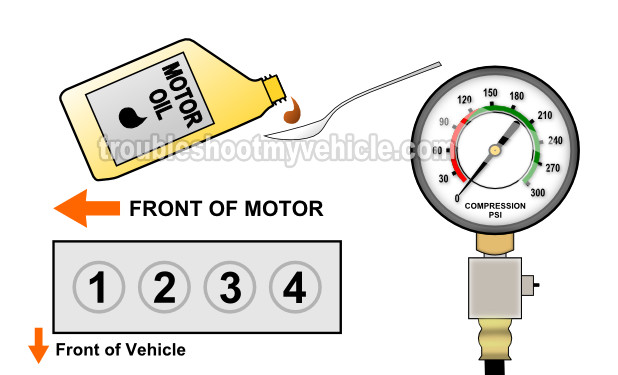
One of the most over-looked tests, when troubleshooting a hard to solve misfire or a no-start problem, is the engine compression test.
Over the years, I've seen lots of folks throw their hands up in the air in frustration, because not matter what got replaced (on the car or pickup), nothing solved the misfire condition or misfire code (P0300, P0301, P0302, P303, P0304).
In this tutorial, we'll explore the compression test as one of the key tests to troubleshoot a misfire code or codes (and of course a no-start problem).
This tutorial supplements the information in the tutorial: How To Diagnose Misfire Codes (GM 2.2L). Also, the info presented here applies to the GM 2.2L 4 cylinder equipped Chevrolet Cavalier, or Pontiac Sunfire, or Chevrolet Sonoma, or GMC Sonoma.
Contents of this tutorial:
ES ![]() You can find this tutorial in Spanish here: Cómo Probar La Compresión Del Motor (GM 2.0L, 2.2L, 2.5L) (at: autotecnico-online.com).
You can find this tutorial in Spanish here: Cómo Probar La Compresión Del Motor (GM 2.0L, 2.2L, 2.5L) (at: autotecnico-online.com).
Tools You'll Need:
- Compression Gauge Tester
- A Helper
- Pen and Paper
Symptoms Of An Engine Compression Problem
Engine compression issues usually fall into one of two categories:
- A low compression is in some but not all cylinders.
- 0 (zero) PSI compression in some or all cylinders.
Regardless of whether the engine has a low compression or zero PSI compression issue, you'll see a range of symptoms that will affect performance, reliability, and drivability. Some of the most common symptoms you'll see include:
Low Compression in Some Cylinders: When one or more cylinders have lower than normal compression, it means that the air-fuel mixture isn't being compressed as effectively as it should be. This can happen due to various reasons such as worn piston rings, damaged valves, or a leaking head gasket. The symptoms of low compression may include:
- Hard Starting or No Start: The engine may struggle to start, especially when cold, or it may not start at all.
- Poor Engine Performance: The engine may feel sluggish, lacking power and responsiveness, particularly during acceleration.
- Misfiring: Misfires, where the fuel mixture fails to ignite at the right time, can occur, leading to rough idling or hesitation during acceleration.
- Excessive Oil Consumption: Oil may leak into the combustion chamber due to worn piston rings or valve seals, causing increased oil consumption and possibly blue smoke from the exhaust.
Zero PSI Compression in Some or All Cylinders: This is a severe issue where one or more cylinders fail to build any compression at all. This can be caused by catastrophic failures such as a blown head gasket, a cracked cylinder head, or a broken piston. The symptoms of zero compression are similar to those of low compression but often more severe:
- Hard Starting or No Start: The engine may completely fail to start due to the lack of compression in one or more cylinders.
- Poor Engine Performance: The engine's performance will be severely compromised, with noticeable loss of power and drivability.
- Audible Engine Noise: You may hear abnormal noises such as knocking or rattling, indicating serious internal damage.
- Reduced Power and Performance: Due to the lack of compression, the engine may struggle to produce power, leading to poor acceleration and overall performance.
Which Compression Tester Should I Buy?
There are lot of engine compression testers to choose from and many places to buy them. I'm gonna' make three recommendations to you:
Disclosure: As an Amazon Associate, I earn from qualifying purchases. If my tutorials help you, using these links is an easy way to support the site at no extra cost to you. Thank you!
TEST 1: Engine Compression Test

Each cylinder, besides needing air, fuel, and spark, to contribute to engine power, also needs to be in good mechanical condition.
If either the cylinder head valves or the engine piston rings are worn and letting the compression created on the power stroke escape, then that cylinder will misfire.
The cool thing is that the engine compression test will let us know the internal health of the engine and find out if a compression problem is causing the engine to misfire or not start.
If you don't have an engine compression tester, check out my recommendations here: Which Compression Tester Should I Buy?
NOTE: The engine should NOT be at normal operating temperature and yet, it should be not be completely cold. So, if you have just turned off the engine, after an extended run time, let it cool down completely. If the engine is cold, start'er up and let'er run about 10 minutes.
OK, here's the test:
- 1
Disconnect all 4 fuel injectors from their electrical connectors. This will prevent fuel injectors from injecting fuel into the engine cylinders.
- 2
Disable the ignition system by disconnecting all of the connectors that plug to the ignition control module/ignition coil assembly.
This important, since the ignition system must NOT SPARK. If the ignition system sparks during the compression test, the ignition coils or ignition control module can be damaged. - 3
Disconnect the spark plug wires from the four spark plugs.
NOTE: Before you disconnect them, be sure and label them so you won't lose their firing order. - 4
Remove all of the four spark plugs from your 2.2L Cavalier (or Sunfire, or S10 Pick Up, Sonoma, or 2.0L, 2.5L equipped vehicle).
Be careful and don't drop any of the spark plugs. Dropping them could cause their ceramic insulator to break and this will cause a misfire. - 5
Thread the engine compression gauge into the spark plug hole for the number 1 engine cylinder (this is the spark plug hole closest to the drive belt).
Hand tighten the compression gauge only! Do not use any type of tool to get it tight. - 6
When everything is ready, have your helper crank the engine. It usually takes about 10 seconds of engine cranking to get the maximum compression reading.
- 7
Once the compression gauge's needle stops climbing, have your helper stop cranking the engine.
- 8
Record the reading on a piece of paper along with the cylinder it belongs to.
- 9
Repeat steps 5 thru' 8 on the remaining engine cylinders.
Let's examine your test results:
CASE 1: All cylinders had 0 PSI. This test result tells you that the engine has an internal mechanical problem.
The most common causes of this condition is a broken timing chain or a blown head gasket.
Your next step should be to check the condition of the timing chain. I would also recommend that you check for a blown head gasket.
CASE 2: One or more cylinders had a low compression value compared to the others. This could be normal or it could be causing a problem.
To find out if the compression values are normal or not, go to: How To Interpret The Engine Compression Test Results.
CASE 3: All compression values were similar and above 120 PSI. This lets you know that a compression problem is not behind the no-start or misfire problem you're trying to troubleshoot.
How To Interpret The Engine Compression Test Results
On high mileage engines, you're not gonna' see the exact same compression value on each of the cylinders. Up to a certain point this is normal and you're not gonna' see any engine performance problems as a result of this variation in the compression values.
What is not normal is to have one or several a compression values that are radically different than the average compression of the good cylinders.
To be a bit more specific, the compression values between the cylinders should not vary more than 15%. If you're scratching your head and wondering how to do this, don't worry, this is how you can find out:
- STEP 1: Multiply the highest compression value by 0.15 (this is the decimal value of 15%).
- STEP 2: Round off the result (for example: 25.6 would become 26).
- STEP 3: Subtract the result (the number that was rounded off) from the highest compression value.
- ANSWER: The result of this subtraction is the lowest possible compression value any cylinder can have.
NOTE: You can also use my online low compression calculator if you want to avoid doing the math. You can find it here: Online Low Engine Compression Calculator (at: easyautodiagnostics.com).
To make better sense of this calculation, I'll give you a specific example on how to do this 15% calculation. Let's say that my 2.2L Chevy Cavalier gave me following compression values when I did a compression test on all 8 cylinders:
| Cylinder | Pressure |
|---|---|
| #1 | 175 |
| #2 | 170 |
| #3 | 170 |
| #4 | 140 |
The next step is to do the math:
- STEP 1: 175 x 0.15 = 26.25.
- STEP 2: 26.25 = 26 (rounded to nearest one).
- STEP 3: 175 - 26 = 149.
- ANSWER: 149 PSI. Any cylinder with this compression (or lower) value will misfire.
Since cylinder #4 gave me a compression value of 140 PSI, I now know that this is the one causing the misfire I'm trying to diagnose.
The next step, after finding out that a cylinder's low engine compression value is not within range, is to do a 'wet' compression test on it. Go to: TEST 2: 'Wet' Engine Compression Test.
TEST 2: 'Wet' Engine Compression Test

If in the previous test (the 'Dry' compression test), you found a cylinder with low or no compression, then you should do a 'Wet' compression test.
All that's involved is the addition of about two tablespoons of oil to the engine cylinder that showed a low or no compression.
The engine oil that you're gonna' add to the cylinder will help determine if the low cylinder pressure or pressures you recorded in the 'Dry' compression test are caused by worn piston rings or worn cylinder head valves.
Depending on whether the compression pressure rises (on your compression tester) or not, you'll be able to say that the problem lies in the piston's rings or in the cylinder head valves.
OK, this is what you need to do:
- 1
Add a small amount of engine oil to the cylinder that reported low compression or no compression in the 'dry' compression test.
The amount should be about 1 to 2 tablespoons of oil. - 2
Install the compression tester onto the cylinder.
Do not use any type of tool to tightened the compression tester. Hand tight is fine. - 3
When all is set up, have your helper crank the engine.
- 4
You'll get one of two results:
1.) The compression value will go up (from the one you recorded before).
2.) The compression value will stay the same.
Let's take a look at what your test results mean:
CASE 1: The compression value shot up. This tells you that the piston compression rings are worn out and thus the problem is in the bottom end (block) of the engine in your GM 2.2L.
In case you're wondering why, it's because the oil you added has helped the piston rings seal better and this results in the compression value/pressure going up.
CASE 2: The compression value stayed the same. This confirms that the problem is in the cylinder head valves.
In case you're wondering why the compression pressure/value didn't shoot up, this is due to the fact that oil can not help the valve seal better. So, when the 'Wet' compression test shows the same test result (no compression), this is a dead give away that the cylinder valves are bent or severely damaged.
Why An Engine Compression Test?
Now, usually all four engine cylinders wear out evenly. But every now and then, either thru' lack of maintenance or other repair issues that happen along the way of several thousands of miles and/or years, one or several engine cylinders wear out at an accelerated pace. When this happens, no matter what gets replaced, like: spark plugs, ignition coils, fuel injectors, spark plug cables, etc, nothing solves the misfire codes (P0300, P0301, P0302, P303, P0304) or the misfire condition.
As mentioned earlier, testing the compression of all four cylinders is one of the most overlooked troubleshooting tests. Now, testing the compression of each cylinder is usually done after verifying that each cylinder is getting spark. At the end of this article, you'll find some more test articles (GM 2.2L specific test articles) that'll help you to further test a misfire condition.
Related Test Articles
Now, if the compression readings on your Chevy (Cavalier, S10 Pick Up, or GMC Sonoma, or Pontiac Sunfire) indicated that everything is OK, and yet the car or pickup is still misfiring, you can find more test articles here: 2.2L GM Index Of Articles.
- How To Test The Manifold Absolute Pressure (MAP) Sensor (GM 2.2L)
- GM 2.2L Fuel Injector Noid Light Test.
- How To Diagnose Misfire Codes (GM 2.2L)
- How To Test The GM 2.2L Ignition Coil Pack (this info is found at easyautodiagnostics. Com).

If this info saved the day, buy me a beer!




